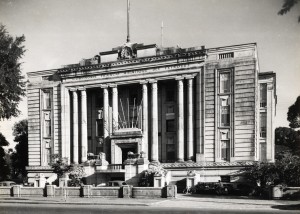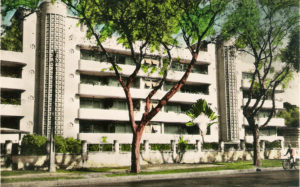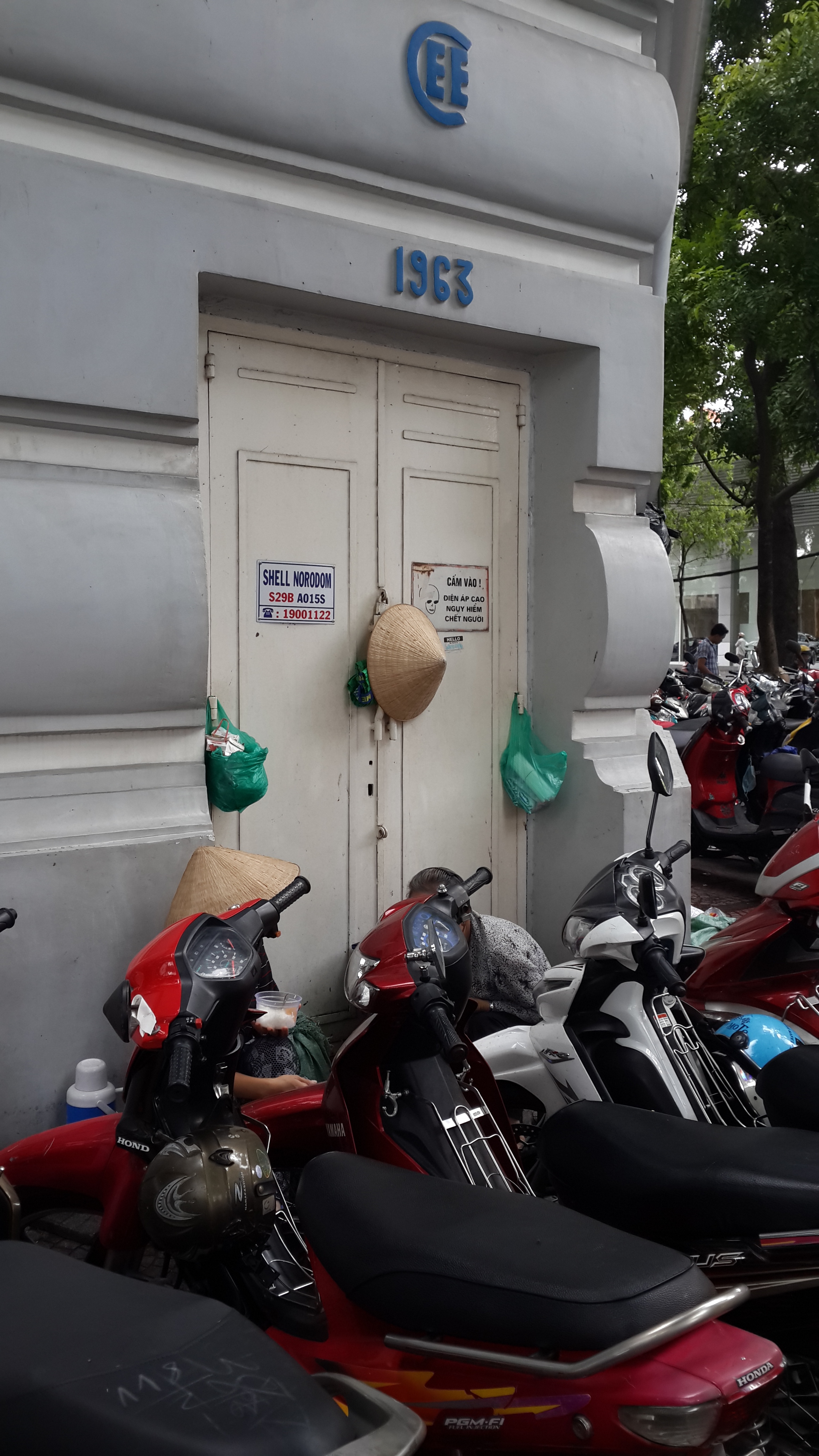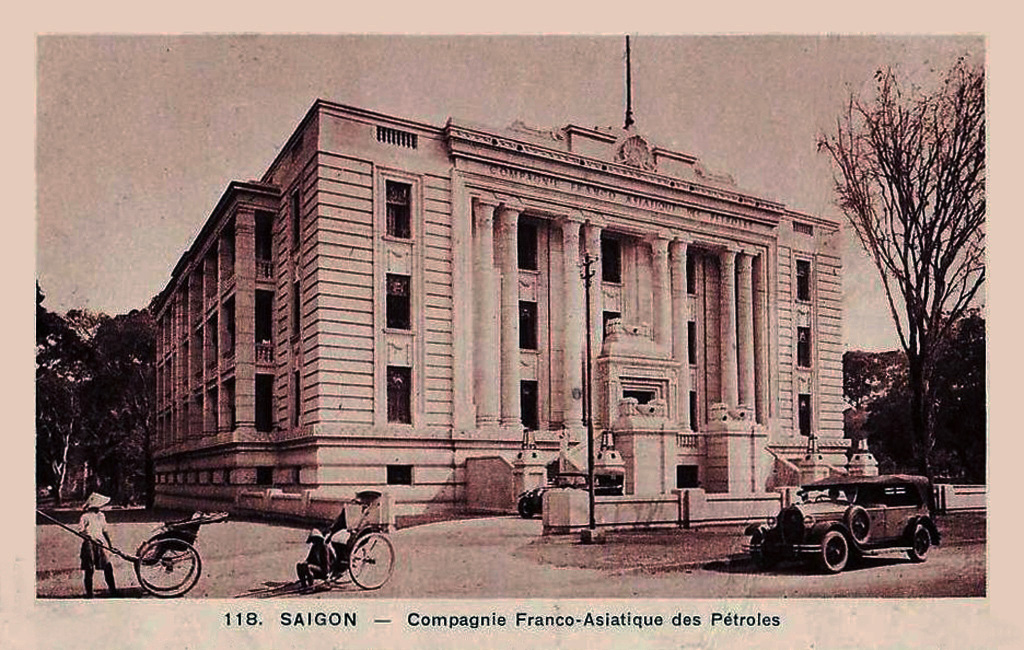Operating in Saigon from 1911, the Paris-based Compagnie Franco-Asiatique des Pétroles was based initially at 4 rue d’Adran (Hồ Tùng Mậu), moving in 1923 to 100 boulevard de la Somme (Hàm Nghi). During this period, branch offices were also established in Hải Phòng and Tourane (Đà Nẵng).
However, in the early 1930s, the company commissioned the construction of a more grandiose headquarters at 15 boulevard Norodom – the building which still stands today at the junction of Lê Duẩn and Tôn Đức Thắng in Hồ Chí Minh City.
In 1952, the Compagnie Franco-Asiatique des Pétroles withdrew from Indochina and its former headquarters building became the main office of Shell Vietnam, the local operating company of the Shell Group.

The Shell Vietnam headquarters pictured in 1955
Described in 1960s publicity material as the “doyenne of petrol companies in Việt Nam, providing for 60% of the country’s consumption,” Shell Vietnam was later revealed by its former president Louis Wesseling to have failed to control its oil shipments, permitting 7% of the fuel refined by the company to find its way to Hà Nội.
Shell had a long history of association with the British film industry – in the UK it sponsored many films in the 1920s and in 1934 it set up its own in-house documentary film unit which produced a wide range of films on subjects often unrelated to the company’s products and services. During the late 1950s, Shell Vietnam opened a tiny 48-seat cinema known as the “Shell Theatre” at its Saigon headquarters building, where these and other British films were screened to the Saigon public.
After 1975 Shell’s assets in Việt Nam were transferred to the Vietnam National Petroleum Corporation (Petrolimex), the current occupant of 15 Lê Duẩn.
In 1952-1953, Shell also took over the former Bâtiment de la Marine nationale building at nearby 7 Thống Nhất (the name by which boulevard Norodom was known in the period 1955-1975).

Paul Veysseyre’s former Bâtiment de la Marine nationale building at 7 Thống Nhất, later the Shell Vietnam apartments, the South Vietnamese Prime Minister’s Office and now the Office of the Government at 7 Lê Duẩn
The building had been designed by prolific Paul Veysseyre of the Shanghai-based Agence Léonard-Veysseyre-Kruze, who also designed the Brasseries et Glacières d’Indochine (BGI) buildings in both Saigon and Chợ Lớn, the former Cité Hui-Bon-Hoa, now the Government Guest House at 1B Lý Thái Tổ, the former Cité Laréynière, now the FOSCO Building at 40 Bà Huyện Thanh Quan, and the apartment building at 73 Cao Thắng.
It accommodated many of Shell’s managerial staff until 1955, when it was acquired by the government and converted into the office of the Prime Minister of the Republic of Việt Nam. From that time onwards, the easternmost section of Nguyễn Du street immediately behind it (which originally connected Nguyễn Bỉnh Khiêm with Cường Để, now Tôn Đức Thắng boulevard) was closed off for security reasons, and it has remained closed ever since. After 1975, the former Bâtiment de la Marine nationale building at 7 Lê Duẩn became the Office of the Government.
The T78 Army Guest House (Nhà Khách T78) at 145 Lý Chính Thắng in District 3 was also built in the late 1950s for the Shell Oil company. It contains numerous residential buildings from that era; one apartment block is very similar in design to the former Bâtiment de la Marine nationale building, and may have been designed by former associates of Paul Veysseyre; another was designed by modernist architect Nguyễn Văn Hoa of the Văn Phòng Kiến Trúc Hoa-Thâng-Nhạc architectural partnership.
Intriguingly, it was also Shell which originally commissioned the construction of the 10-storey SUFO apartment building at 22 Gia Long (Lý Tự Trọng), yet another late 1950s modernist work by Nguyễn Văn Hoa. However, by the mid 1960s that building was occupied mainly by personnel from USAID and the CIA, who named it the Pittman Apartments. On 29 April 1975, its rooftop famously served as one of several helicopter evacuation points in Saigon.

15 Lê Duẩn today

Thanks to Alex Slingeland for providing this image of the 1963 electricity station at the rear of 15 Lê Duẩn and its sign which reads “Shell Norodom”
Tim Doling is the author of the guidebook Exploring Saigon-Chợ Lớn – Vanishing heritage of Hồ Chí Minh City (Nhà Xuất Bản Thế Giới, Hà Nội, 2019)
A full index of all Tim’s blog articles since November 2013 is now available here.
Join the Facebook group pages Saigon-Chợ Lớn Then & Now to see historic photographs juxtaposed with new ones taken in the same locations, and Đài Quan sát Di sản Sài Gòn – Saigon Heritage Observatory for up-to-date information on conservation issues in Saigon and Chợ Lớn.


